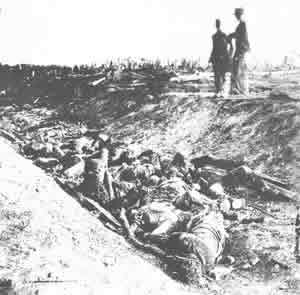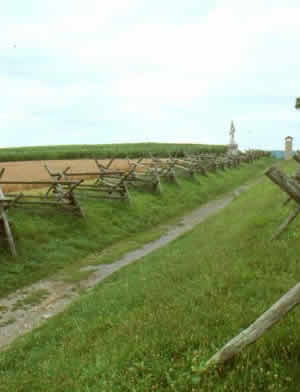The Battle of Antietam Museum

More American soldiers (617,528) died during the 1861-65 American Civil War than in any other conflict involving Americans. The next worse loss of life was in WW II when 407,316 were killed (Morison and Commager 1950, p. 653). These figures cannot compare to the millions of Russian, German and other European deaths recorded in WW II (Beevor 2002), but from a then total American population of only 31.4 million (1860 census figure) the large number of deaths together with the privations reported by prisoners of war on both sides had a profound effect on the country. The Battle of Antietam on 17 September 1862 was a seminal event in American history and a major turning point of the Civil War.
Oddly, this conflict is rarely called “Civil War” in the South, even to this present day. Preferred titles there are “The War between the Sates” or, even in Charleston, where the first cannon was fired by the South into Union-held Fort Sumter, “The War of Northern Aggression.” Exactly how the static Fort Sumter, surrounded by sea, was “aggressing” is not clear to the casual observer. Similarly, the North’s “Battle of Antietam” is known in most Southern States as the “Battle of Sharpsburg”.
Antietam was the first major Civil War battle fought outside the Confederacy and it marked the end of a dramatic northern push by Confederate General Robert E. Lee in 1862. Union forces were able to engage the enemy only after an appalling security breach by Confederate forces, a stroke of sheer luck in discovering and reporting secret orders and an uncharacteristically nimble response by the Union commander, General George B. McClennan. Antietam also preceded Lincoln’s Preliminary Emancipation Proclamation, five days later. This broadened the base of the war and made it more difficult for European nations, such as England and France, to support the Confederate States that still countenanced slavery.
More Americans fell that day at Antietam than in any other battle in history. The casualty toll (22,720 killed, wounded and captured) was nine times that of American casualties during D-Day (2,510). No fewer than six generals were killed and 12 sustained wounds.
Well-documented
The Battle of Antietam is amazingly well-documented. The battlefield itself is preserved today as an historic monument, close to its original state, and its numerous historic sites are clearly but discretely signposted with monuments and other reminders. One major factor contributing to the battlefield’s present day authenticity was Alexander Gardner’s photography. Arriving within a couple of days of the action, Gardner took 70 photographs of the battlefield, before they buried the dead. This was the first time a major armed conflict had been recorded in this manner. Instead of the “death or glory” cavalry charge, beloved of the painters and artists, here was the grim reality of war: thousands of dead bodies lying grotesquely as they fell.
 |
 |
| Bloody Lane after the battle (left, Alexander Gardner photo) and now (Jim Strongon photo). | |
To put Antietam into context, the overt cause of the “War between the States” was the threat of Abraham Lincoln declaring freedom for all American slaves. This aroused considerable political and judicial muscle flexing but there were wider issues contributing to the long-threatened secession resolutions of the Confederate State parliaments in 1860-1. Chief among these was a perceived constitutional “States versus Federal” right to determine policy.
The election of Abraham Lincoln as Federal President and his universal anti-slavery platform was anathema to Southern “State rights”, despite Lincoln’s repeated statements that at that time “slavery was not an issue”. If Lincoln ever enacted his highly forecast anti-slavery legislation, the slave owners argued, he would pauperise the South. What would stop the more numerous Northern States banding together to tax or otherwise skim the profits from lucrative Southern exports such as cotton and tobacco? The Confederates fired the first gun on 12 April 1861, towards Fort Sumter, near Charleston, South Carolina, ostensibly to beat off a Union attempt to resupply the garrison to which they were laying siege.
Naval strategy
The North’s naval strategy was obvious and played a decisive part in the struggle. After a slow start due to shortages of ships and men, the Union had four squadrons in place by July 1861 to blockade the seven or eight Southern ports that had been loading more than 6,000 ships a year. Never perfect, about 800 cargo ships ran the blockade in its first year and small ships could also sail along the intricate inland North Carolina waterways, then slip through any of dozens of outlets once the horizon looked clear. The South wanted England or France to relieve the blockade to facilitate their cotton exports, but Europe held substantial reserve stocks and the major powers were in no hurry to intervene.
Union forces captured a small number of bases along the South’s coast, chiefly to service the blockading ships. This strategy also pinned down Southern troops, but no major effort was made either to mount an offensive from these bases or to recapture them.
Inland, Brigadier Ulysses S. Grant chalked up notable Union successes on the Mississippi in early 1862. He was supported by freshwater gunboats moving downstream and a saltwater fleet commanded by Captain (Damn the torpedoes …) Farragut sailing up river from the Gulf of Mexico. However, Grant was surprised by a counterattack from Fort Donelson, Shiloh, on 6 April 1862 that cost 13,000 of his 63,000 Union troops engaged. Confederate losses were listed as 11,000 out of 40,000 (Morison and Commager 1950 p. 677). Higher authority then enforced a much more pedestrian tempo in that theatre, but it was Grant who finally accepted the surrender of General Robert E. Lee and all his Confederate forces three years later at Appomatox, 9 April, 1865.
Major General McClellan, commanding Union troops in the Washington theatre in 1862, followed a similar pedestrian strategy. He was a great logistics manager, but he consistently overestimated his opposition and lacked the initiative and flexibility of the South’s Generals Lee and Thomas (Stonewall) Jackson in battle. After an aborted mid-1862 approach aiming to capture Richmond with a numerically superior, better-equipped and better-trained army, the South stalemated or beat McClellan piecemeal. He retreated back to Washington, supported by Union naval forces, including the revolutionary ironclad Monitor, that kept him supplied and provided Naval Gunfire Support for his troops.
Manassas mauling
On 29-30 August 1862, Lee and Jackson badly mauled the Union Army of the Potomac at Manassas. With Virginia now clear of Union forces, they commenced an invasion of then-neutral Maryland on 4 September, aiming to march through Maryland to capture a railway bridge in Harrisburg, Pennsylvania. This thrust would nearly cut the Union in two. Lee expected the rich countryside to provide food for his hungry army and he hoped the invasion would press Maryland to join the Southern cause. Wider afield, such signal success might also swing a European nation or two behind the Confederacy.

Abraham Lincoln (centre, in top hat) with some of his Generals.
Lee expected McClellan to take weeks to reorganise, but Private Barton W. Mitchell of the 27th Indianas, discovered Lee’s Scheme of March, Special Order 191, dated 9 September, in an abandoned Confederate campsite on 12 September. “Here is a paper with which, if I cannot whip Bobby Lee, I will be willing to go home,” McClellan is reported to have said later that day. He rapidly deployed his 85,000 men to counter the South’s bold thrust.
Lee detected McClellan’s approach and, unable to manoeuvre, quickly set up defensive perimeters with his available troops. On 17 September, a series of desperate uncoordinated attacks and counter-attacks ensued. These became known as the Battle of Antietam. There were three major battle phases, morning, midday and afternoon, at five well-documented major sites: Cornfield, West Woods, Bloody Lane, Burnside Bridge and Final Attack. These exhausted Lee’s army, but failed to destroy it.
The Cornfield Battle raged for most of the forenoon as the generals threw division after division into the fray. At Burnside Bridge, a few hundred Confederate riflemen held off General Burnside’s entire Corps for most of the day. This vital delay allowed a relief force to march up from Harpers Ferry, 27 kilometres away, and block Burnside’s late afternoon thrust towards the Confederate Army’s headquarters and main line of retreat. McClellan failed to follow up the next day, allowing most of Lee’s survivors to escape.
Day trip from Washington, Antietam is eminently placed for a day trip excursion from Washington, DC, only 114 kilometres away. Consider visiting Antietam by car and wandering around the exhibits in your own time, guidebook in hand, or booking any of a number of battlefield guided tours. Visit the National Parks Service website below for more information.
References:
Beevor, A. Berlin: The downfall 1945. Penguin Books: London, 2003.
Morison S.E. and H.S. Commager. The growth of the American Republic, Vol 1, 4th Ed. Oxford University Press: New York, 1950.
National Parks Services: http://www.nps.gov/anti.
